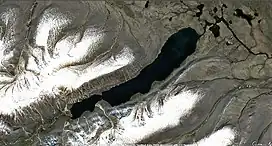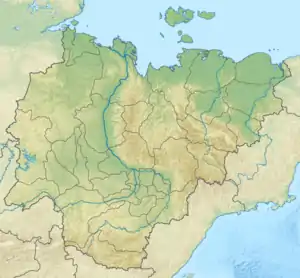| Chibagalakh Range | |
|---|---|
| Чибагала̀хский хребет / Чыбаҕалаах | |
 Northern slopes of the range and lake Tabanda Sentinel-2 image. | |
| Highest point | |
| Peak | Unnamed |
| Elevation | 2,449 m (8,035 ft) |
| Dimensions | |
| Length | 250 km (160 mi) NW/SE |
| Width | 40 km (25 mi) NE/SW |
| Geography | |
 Location in Sakha, Russia | |
| Country | Russia |
| Federal subject | Sakha Republic |
| Range coordinates | 66°00′N 140°00′E / 66.000°N 140.000°E |
| Parent range | Chersky Range, East Siberian System |
| Geology | |
| Age of rock | Early Cretaceous |
| Type of rock | Metamorphic rock, shale and sandstone |
The Chibagalakh Range (Russian: Чибагала̀хский хребет; Yakut: Чыбаҕалаах) is a mountain range in the Sakha Republic (Yakutia), Far Eastern Federal District, Russia.
Despite the beauty of its landscapes the range is rarely visited owing to its remoteness. In 1977 a group of tourists from Kharkov visited the area and climbed Salishchev Peak.[1] The nearest airport is Ust-Nera Airport.[2]
Geology
With a length of over 200 kilometers (120 mi) the Chibagalakh Range is the largest batholith in the area of Northeastern Russia. It is in part peraluminous two-mica granite —a granite containing both muscovite and biotite micas), being the showpiece of the "collisional" granites.[3][4]
Geography
The Chibagalakh Range rises in the central area of the Chersky Range, between the valley of the Tuostakh —a tributary of the Adycha, and the valley of the Chibagalakh river of the Indigirka basin,[5] while to the southeast lies the valley of the Charky river. The range stretches in a roughly northwest–southeast direction for about 250 kilometers (160 mi). The highest peak is an unnamed 2,449 metres (8,035 ft) high peak.
The Borong Range, another subrange of the Chersky Mountains, rises to the west parallel to it, the smaller Porozhny Range to the south, the Dogdo Range to the north and the Chemalgin Range to the northeast. Lake Tabanda is located in the range.[6]
.png.webp)
Flora
There are forests of larch covering the mountain slopes. At higher elevation there is a belt of dwarf cedar and further up mountain tundra.[5]
See also
References
- ↑ Пик Салищева Archived 2021-05-11 at the Wayback Machine (in Russian)
- ↑ Google Earth
- ↑ Phanerozoic continental growth and gold metallogeny of Asia
- ↑ Main Belt Granites-Chersky Range
- 1 2 Чибагалахский хребет, Great Soviet Encyclopedia
- ↑ USSR 1:1,000,000 scale Operational Navigation Chart, Sheet C-6, 3rd edition